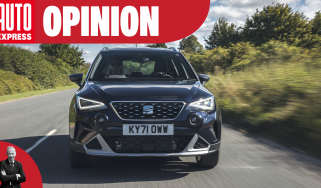Kia Sportage - Engines, performance and drive
The Kia Sportage is well set-up for town driving, while hybrid models provide decent pace

Comfort and refinement are the Kia Sportage’s key strengths. Its soft suspension set-up means this family SUV is able to deal effectively with bumps in the road and reduce unpleasant jolts intruding into the cabin.
There is a feeling that you’re not as well-connected to the road as a Ford Kuga, especially over uneven surfaces and mid-corner undulations, and the Sportage will lean a bit more in corners. If you’re after a sportier drive, you may wish to consider the Mazda CX-5 or even the SEAT Ateca, because both are better for tackling the twisty stuff.
| Model | Power | 0-62mph | Top speed |
| Sportage 1.6 T-GDi 2 | 157bhp | 9.8seconds | 119mph |
| Sportage 1.6 HEV 2WD GT-Line | 212bhp | 8.4seconds | 115mph |
| Sportage 1.6 PHEV GT-Line AWD | 248bhp | 8.4sceonds | 112mph |
What is the Kia Sportage like to drive?
In town
You’ll find the steering in the Sportage to be a touch light and lacking in feel, but the payoff is that the Sportage is easy to pilot around town and in heavier urban traffic – where family car buyers will likely be doing most of their driving. The Sportage (especially in smaller 18-inch wheels) has a smoother and more comfortable ride at low speeds than the Nissan Qashqai.
If you go for the hybrid Sportage, it feels more lethargic when pulling away from a standstill than the equivalent e-Power Qashqai, which has a more responsive accelerator pedal and stronger feeling electric motor.
On A- and B-roads
Once you’ve got over that initial reluctance to move off, the Sportage has enough performance to cater for most people’s needs. On paper, it takes half a second longer to cover the 0-62mph dash than the equivalent e-Power Qashqai, but once rolling, both the Sportage and Qashqai offer similar mid-range grunt. The engine note in the Sportage sounds harsh, though, so it’s best to avoid putting your foot down unless it’s really needed.
Used - available now

2020 KIA
Sportage
60,693 milesAutomaticDiesel2.0L
Cash £15,487
2020 KIA
Sportage
25,632 milesManualDiesel1.6L
Cash £13,200
2023 KIA
Sportage
32,206 milesManualPetrol1.6L
Cash £20,700
2023 KIA
Sportage
2,830 milesAutomaticPetrol1.6L
Cash £32,800The Kia’s softer suspension set-up is clear on a twisty road because there’s more body lean through the turns. It feels a bit lazy when entering a corner, while the steering in the Sportage isn’t quite as precise as a Kuga or Ateca, either. As with the Qashqai, these aren’t huge negatives for a car of this type, and the softer suspension means that for the most part, the Sportage is very forgiving. Some larger compressions can cause the front axle to bounce a couple of times before it fully settles, though.
On the motorway
At higher speeds, the Sportage has fine straight-line stability on the motorway, and refinement is generally good. Wind noise is well muted, and road rumble is similarly well contained. The engine in all versions sounds a harsh when accelerating up to the national speed limit, but it quietens down to blend in with the background hum once you’ve reached your cruising speed. There’s enough low-down torque (even in the least powerful petrol) to allow you to leave the car in sixth and not worry all that much about changing down for inclines.
0-62mph acceleration and top speed
The mild-hybrid petrol Sportage is the least potent in the line-up, but it still returns a respectable 157bhp and a 0-62mph sprint time of 9.8 seconds for the manual, or a slightly swifter 9.3 seconds sprint with the dual-clutch automatic. The manual has a top speed of 119mph, while the auto is marginally slower at 117mph.
The 212bhp full-hybrid's extra punch dispatches the 0-62mph run in 8.4 seconds, while the all-wheel drive set-up's extra weight increases the full hybrid's benchmark sprint time to 8.7 seconds. Both versions have a top speed of 115 mph.
The most expensive plug-in hybrid model has more power at 248bhp, but has a bigger, heavier battery and standard four-wheel drive, so it doesn’t get from 0-62mph any faster than the full-hybrid’s 8.4 second time. The top speed is slightly reduced at 112mph.








